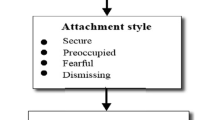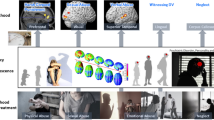Abstract
Objectives To study mother-to-infant emotional involvement at birth, namely factors (socio-demographics, previous life events, type of delivery, pain at childbirth, support from partner, infant characteristics, early experiences with the newborn, and mother’s mood) that interfere with the mother’s positive, negative and not clear emotions toward the newborn. Methods The Bonding Scale (an extended Portuguese version of the ‘New Mother-to-Infant Bonding Scale’) and the Edinburgh Postnatal Depression Scale were administrated during the first after delivery days to 315 mothers recruited at Júlio Dinis Maternity Hospital (MJD, Porto, Portugal). Results A worse emotional involvement with the newborn was observed when the mother was unemployed, unmarried, had less than grade 9, previous obstetrical/psychological problems or was depressed, as well as when the infant was female, had neonatal problems or was admitted in the intensive care unit. Lower total bonding results were significantly predicted when the mother was depressed and had a lower educational level; being depressed, unemployed and single predicted more negative emotions toward the infant as well. No significant differences in the mother-to-infant emotional involvement were obtained for events related to childbirth, such as type of delivery, pain and partner support, or early experiences with the newborn; these events do not predict mother’s bonding results either. Conclusion The study results support the need for screening and supporting depressed, unemployed and single mothers, in order to prevent bonding difficulties with the newborn at birth.
Similar content being viewed by others
References
Winnicott, D. (1957). The child, the family, and the outside world classics in child development. USA: Winnicott.
Klaus, M. H., & Kennell, J. H. (1976). Maternal-infant bonding. Saint Louis: The C. V. Mosby Company.
Kennell, J. H., Trause, M. A., & Klaus, M. H. (1975). Evidence for a sensitive period in the human mother. In Ciba Foundation (Ed.), Parent-infant interaction (pp. 87–102), Vol 33. Amsterdam: Association Scientific Publishers.
Stern, D. (1995). The motherhood constellation. New York, NY: Harper Collins.
George, C., & Solomon, J. (1999). Attachment and caregiving: The caregiving behavioral system. In J. Cassidy & P. Shaver (Eds.), Handbook of attachment: Theory, research and clinical applications (pp. 649–667). New York, NY: The Guilford Press.
Bowlby, J. (1958). The nature of the child’s tie to his mother. International Journal of Psychoanalytic, 39, 350–373.
Klaus, M. H., Kennell, J. H., & Klaus, P. H. (1995). Bonding: Building the Foundations of Secure Attachment and Independence. USA: Addison Wesley Publishing Company.
Fleming, A. S., O’Day, D. H., & Kraemer, G. W. (1999). Neurobiology of mother-infant interactions: Experience and central nervous system plasticity across development and generations. Neuroscience Biobehavioral Review, 235, 6736–6785.
Eibl-Eibesfeldt, I. (1971). Love and Hate: The natural history of behavior patterns. New York, NY: Holt, Rinehart, & Winston, Inc.
Richards, M. P. M. (1971). Social interaction in the first weeks of human life. Psychiatric Neurology Neurochirurgia, 74, 35–42.
Figueiredo, B., Costa, R., Marques, A., Pacheco, A., & Pais, A. (2007). Mother and father-to-infant initial emotional involvement. Early Child Development and Care, 177(5), 521–532.
Fleming, A. S., Rubble, D., Krieger, H., & Wong, P. Y. (1997). Hormonal and experiential correlates of maternal responsiveness during pregnancy and the puerperium in human mothers. Hormone and Behavior, 31, 145–158.
Taylor, A., Atkins, R., Kumar, R., Adams, D., & Glover, V. (2005). Mother-to-infant bonding scale: Links with early maternal mood. Archives of Women’s Mental Health, 81, 45–51.
Figueiredo, B., Marques, A., Costa, R., Pacheco, A., & Pais, A. (2005). Bonding: Escala para avaliar o envolvimento emocional dos pais com o bebé. Psychological, 40, 133–154.
Fleming, A. S., Ruble, D. N., Flett, G., & Shaul, D. L. (1988). Postpartum adjustment in first-time mothers: Relations between mood, maternal attitudes and mother infant interactions. Development Psychology, 241, 71–81.
Troy, N. W. (1993). Early contact and maternal attachment among women using public health care facilities. Applied Nursing Research, 64, 161–166.
Troy, N. W. (1995). The time of first holding of the infant and maternal self-esteem related to emotions of maternal attachment. Women Health, 223, 59–72.
Chalmers, B., Samarskaya, M. E., Tkatchenko, E., & Wallington, T. (1998). Women’s perceptions of birth in St Petersburg, Russian Federation. Journal of Reproductive Infant Psychology, 16, 243–258.
MacFarlane, J. A., Smith, D. M., & Garrow, D. H. (1978). The relationship between mother and neonate. In S. Kitzinger & J. A. Davis (Eds.), The place of birth. New York, NY: Oxford University Press.
Newton, N., & Newton, M. (1962). Mother’s reaction to their newborn babies. Journal of the American Medical Association, 181, 206–210.
Robson, K. S., & Kumar, R. (1980). Delayed onset of maternal affection after childbirth. The British Journal of Psychiatry, 136, 347–353.
Robson, K. S., & Moss, H. (1970). Patterns and determinants of maternal attachment. Journal of Pediatric, 77, 976–985.
Insel, T. R. (1992). Oxytocin—A neuropeptide for affiliation: evidence from behavioral, receptor autoradiographic, and comparative studies. Psychoneuroendocrinology, 171, 3–35.
Insel, T. R. (1997). A neurobiological basis of social attachment. American Journal of Psychiatry, 1546, 726–735.
Neumann, I. D. (2003). Brain mechanisms underlying emotional alterations in the peripartum period in rats. Depression and Anxiety, 17(3), 111–121.
Isabella, R. A. (1994). Origins of maternal role satisfaction and its influences upon maternal interactive behavior and infant-mother attachment. Infant Behavior and Development, 17, 381–387.
Isabella, R. A., & Belsky, J. (1985). Marital change during the transition to parenthood and security of infant-parent attachment. Journal of Family Issues, 64, 505–522.
Edelstein, R. S., Alexander, K. W., Shaver, P. R., Schaaf, J. M., Quas, J. A., Lovas, G. S., & Goodman, G. S. (2004). Adult attachment style and parental responsiveness during a stressful event. Attachment & Human Development, 61, 31–52.
Slade, A., Belsky, J., Aber, J. L., & Phelps, J. L. (1999). Mothers’ representations of their relationships with their toddlers: Links to adult attachment and observed mothering. Development of Psychology, 353, 611–619.
Krpan, K. M., Coombs, R., Zinga, D., Steiner, M., & Fleming, A. S. (2005). Experiential and hormonal correlates of maternal behavior in teen and adult mothers. Hormones and Behavior, 471, 112–122.
Feldman, R., Weller, A., Leckman, J. F., Kuint, J., & Eidelman, A. (1999). The nature of the mother’s tie to her infant: Maternal bonding under conditions of proximity, separation and potential loss. Journal of Child Psychology and Psychiatry, 406, 929–939.
Kumar, R. C. (1997). “Anibody’s child”: Severe disorders of mother-to-infant bonding. The British Journal Psychiatry, 171, 175–181.
Carek, D. J., & Capelli, A. J. (1981). Mother’s reactions to their newborn infants. Journal of the American Academy of Child Psychiatry, 20, 16–31.
Robson, K. S. (1967). The role of eye-eye contact in maternal infant attachment. Journal of Child Psychology Psychiatry, 8, 13–25.
Cummins, L. H., Scrimshaw, S. C. M., & Engle, P. L. (1988). Views of cesarean birth among primiparous women of Mexican origin in Los Angeles. Birth, 15, 164–170.
DiMatteo, M. R., Morton, S. C., Lepper, H. S., Damush, T. M., Carney, M. F., Pearson, M., & Kahn, K. L. (1996). Cesarean childbirth and psychosocial outcomes: A meta-analysis. Health Psychology, 154, 303–324.
Garel, M., Lelong, N., & Kaminski, M. (1987). Psychological consequences of caesarean childbirth in primiparas. Journal of Psychosomaic Obstetrics and Gynecology, 63, 197–209.
Marut, J. S., & Mercer, R. T. (1979). Comparison of primiparas’ perceptions of vaginal delivery and cesarean births. Nursing Research, 285, 260–266.
Tulman, L. J. (1986). Initial handling of newborn infants by vaginal delivery and cesarean-delivered mothers. Nursing Research, 35, 296–300.
Kearney, M. H., Cronenwett, L. R., & Reinhart, R. (1990). Caesarean delivery and breastfeeding outcomes. Birth, 17, 97–103.
Taylor, A., Littlewood, J., Adams, D., Doré, C., & Glover, V. (1994). Serum cortisol levels are related to moods of elation and dysphoria in new mothers. Psychiatry Research, 54, 241–247.
Ransjo-Arvidson, A. B., Matthiesen, A. S., Lilja, G., Nissen, E., Widstrom, A. M., & Uvnas-Moberg, K. (2001). Maternal analgesia during labor disturbs newborn behavior: Effects on breastfeeding, temperature, and crying. Birth, 281, 5–12.
Sepkoski, C. M., Lester, B. M., Ostheimer, G. W., & Brazelton, T. B. (1992). The effects of maternal epidural anesthesia on neonatal behavior during the first month. Development Medical and Child Neurology, 3412, 1072–1080.
Huckabay, L. M. (1999). The effect on bonding behavior of giving a mother her premature baby’s picture. Scholarly Inquiry for Nursing Practice, 134, 349–362.
Widstrom, A. M., Wahlberg, V., Matthiesen, A. S., Eneroth, P., Uvnas-Moberg, K., Werner, S., & Winberg, J. (1990). Short-term effects of early suckling and touch of the nipple on maternal behaviour. Early Human Development, 213, 153–163.
Gomes-Pedro, J., Bento de Almeida, J., Silveira da Costa, C., & Barbosa, A. (1984). Influence of early mother-infant contact on dyadic behaviour during the first month of life. Development Medical and Child Neurology, 265, 657–664.
Simpson, J. A. (1999). Attachment theory in modern evolutionary perspective. In J. Cassidy & P. R. Shaver (Eds.), Handbook of attachment (pp. 115–140). New York, NY: Guilford Press.
Lee, R. E. (1995). Women look at their experience of pregnancy. Infant Mental Health Journal, 163, 192–205.
Field, T. (1990). Infancy. Cambridge: Harvard University Press.
Lozoff, B., Jordan, B., & Malone, S. (1988). Childbirth in cross-cultural perspective. Marriage & Family Review, 123–124, 35–60.
Brazelton, T. B., & Cramer, B. G. (1990). Earliest relationship: Parents, infants, and the drama of early attachment. New York: Addison-Wesley Publishing.
Figueiredo, B., Costa, R., Pacheco, A., Conde, A., & Teixeira, C. (2007). Anxiété, dépression et investissement émotionnel de l’enfant pendant la grossesse. Devenir, 19(3), 243–260.
Lawson, K. L., & Turriff-Jonasson, S. I. (2006). Maternal serum screening and psychosocial attachment to pregnancy. Journal of Psychosomatic Research, 60(4), 371–378.
Righetti, P. L., Dell’Avanzo, M., Grigio, M., & Nicolini, U. (2005). Maternal/paternal antenatal attachment and fourth-dimensional ultrasound technique: A preliminary report. The British Journal of Psychiatry, 96, 129–137.
Niven, C. (1988). Labor pain: Long-term recall and consequences. Journal of Reproductive Infant Psychology, 6, 83–87.
Thune-Larsen, K. B., & Moller-Pedersen, K. (1988). Childbirth experience and postpartum emotional disturbance. Journal of Reproductive Infant Psychology, 64, 229–240.
Augusto, A., Kumar, R., Calheiros, J. M., Matos, E., & Figueiredo, E. (1996). Post-natal depression in an urban area of Portugal: Comparision of childbearing women and matches controls. Psychological Medicine, 26, 135–141.
Cox, J. L., Holden, J. M., & Sagovsky, R. (1987). Detection of postnatal depression. Development of the 10-item Edinburgh Postnatal Depression Scale. The British Journal of Psychiatry, 150, 782–786.
Figueiredo, B. (1997). Postpartum depression, mother-infant interaction and child development, Unpublished doctoral dissertation, Minho University, Braga.
Areias, M. E., Kumar, R., Barros, H., & Figueiredo, E. (1996). Comparative incidence of depression in women and men, during pregnancy and after childbirth. Validation of the Edinburgh Postnatal Depression Scale in Portuguese mothers. The British Journal of Psychiatry, 169(1), 30–35.
Dragonas, T. G. (1992). Greek fathers’ participation in labor and care of the infant. Scandinavian Journal of Caring Science, 63, 151–159.
Klaus, M. H., & Kennell, J. H. (1992). Pregnancy, birth and the first days of life. In M. D. Levine, W. B. Carey, & A. C. Crocker (Eds.), Developmental-behavioral pediatrics (pp. 16–26). Philadelphia, PA: WB Saunders Co.
Brown, J. V., Bakeman, R., Snyder, P. A., Fredrickson, W. T., Morgan, S. T., & Hepler, R. (1975). Interactions of black inner-city mothers with their newborn infants. Child Development, 463, 677–686.
Craig, S., Tyson, J. E., Samson, J., & Lasky, R. E. (1982). The effect of early contact on maternal perception of infant behavior. Early Human Development, 62, 197–204.
Acknowledgments
We would like to thank the mothers that participated in this study. This research was supported by a grant from the Human Development and Health Service of the Calouste Gulbenkian Foundation (Ref.48914) and a grant from the Bial Foundation (Ref.58/02).
Author information
Authors and Affiliations
Corresponding author
Rights and permissions
About this article
Cite this article
Figueiredo, B., Costa, R., Pacheco, A. et al. Mother-to-Infant Emotional Involvement at Birth. Matern Child Health J 13, 539–549 (2009). https://doi.org/10.1007/s10995-008-0312-x
Received:
Accepted:
Published:
Issue Date:
DOI: https://doi.org/10.1007/s10995-008-0312-x




